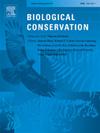Climate and land use change through the eyes of two endemic amphibians: Temporal trajectories of suitability and connectivity reveal differential responses
IF 4.9
1区 环境科学与生态学
Q1 BIODIVERSITY CONSERVATION
引用次数: 0
Abstract
Climate and land-use change are expected to cause habitat loss and fragmentation, conditioning the ability of a species to ultimately persist in a territory. Amphibians are particularly sensitive to such threats due to their life-history traits and small-ranged distributions. Reconstructing how each factor has contributed to the historical trajectories of change in landscape suitability and connectivity, and which process is prevailing (loss or fragmentation) becomes pivotal to plan conservation and mitigation actions at local scale. By combining habitat suitability modelling and circuit- and graph-theory, we determined the temporal change in habitat suitability, functional connectivity, and spatial ecological network functionality for two Italian endemic amphibian taxa, an urodele, the Italian alpine newt, and an anuran, the Apennine yellow-bellied toad. The temporal trajectories for the alpine newt showed a gradual loss of suitability and functional connectivity, which is predicted to continue in the future, but with a steep drop in the network functionality already occurred in the last thirty-year period. This suggests that restoring connectivity may be the key for conservation actions of this endemism. Differently, in the Apennine yellow bellied toad, we found that the spatial network has already collapsed, while future projections highlighted a huge habitat loss issue. Conservation efforts for this species should therefore be focused on preserving current suitable areas and identifying possible translocation sites where to settle new populations. The approach we proposed is highly generalizable and can be updated to include alternative scenarios and simulated conservation actions, providing stakeholders with a target-defined prioritization.

求助全文
约1分钟内获得全文
求助全文
来源期刊

Biological Conservation
环境科学-环境科学
CiteScore
10.20
自引率
3.40%
发文量
295
审稿时长
61 days
期刊介绍:
Biological Conservation is an international leading journal in the discipline of conservation biology. The journal publishes articles spanning a diverse range of fields that contribute to the biological, sociological, and economic dimensions of conservation and natural resource management. The primary aim of Biological Conservation is the publication of high-quality papers that advance the science and practice of conservation, or which demonstrate the application of conservation principles for natural resource management and policy. Therefore it will be of interest to a broad international readership.
 求助内容:
求助内容: 应助结果提醒方式:
应助结果提醒方式:


